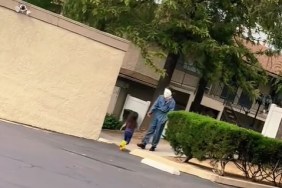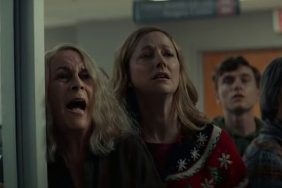Michael Myers is coming back… again. Again.
John Carpenter, the director of the original Halloween, announced earlier today on Stereogum that the next Halloween film – an upcoming reboot produced by Blumhouse – is now going to take place in “almost an alternative reality. It picks up after the first one and it pretends that none of the other [sequels] were made.”
It’s a decision that’s bound to be controversial, but one with a serious precedent within the Halloween series. In 1998, Halloween H20 celebrated the 20th anniversary of the series by pretending that only first two Halloween movies existed, abandoning a bizarre ongoing storyline about supernatural cults and psychic cousins. Halloween H20 featured the return of Jamie Lee Curtis as original series protagonist Laurie Strode, and also featured a seemingly final, knockdown battle between Laurie and her mass murdering brother, Michael Myers. (Final, that is, until the ill-fated online reality television installment, Halloween: Resurrection.)
It seemed to many fans that Halloween H20 had returned the series to its roots, but of course that wasn’t truly the case. Halloween H20 didn’t ignore all the sequels, it only ignored most of them, keeping Halloween II in the series’ continuity and legitimizing that first sequel’s revelation that Laurie Strode and Michael Myers were siblings all along.

Dimension Films
But although the connection between Strode and Myers has been an official element of the series for nearly 30 years now – and even found its way into Rob Zombie’s remakes – it was never a part of the original Halloween’s appeal. And it’s a plot point that has been holding the series back ever since it was introduced, even – arguably – sullying the original film that changed the horror landscape in the first place.
The original Halloween, for those who don’t remember, wasn’t about a serial killer returning home to murder his sister. It was about a serial killer with no soul, and no motive whatsoever. Dr. Sam Loomis, played by Donald Pleasance, spent the whole film trying to convince the world that Michael Myers was beyond everything we understood about human psychology.

Compass International
Psychology was experiencing a surge in respectability in the late 1970s, and undermining the practice was a frightening prospect. Much like The Exorcist forced audiences to wonder what would happen if secular science failed, and only religion could solve our problems, Halloween argued that evil might exist outside the human capacity to understand its motives. Michael Myers was human, but he was also the boogeyman, incapable of reason and figuratively unstoppable. Maybe – just maybe – even literally.
Despite an ending where Michael Myers’ seemingly dead body disappears, John Carpenter has admitted time and again that the finale of Halloween wasn’t supposed to make room for a sequel. It was simply supposed to be ambiguous, and unsettling. Still, Halloween became one of the most profitable movies ever made and a sequel was eventually produced three years later, picking up just minutes after the first film and following Michael Myers as he stalks Laurie Strode back to a mostly empty hospital.
Why was he stalking Laurie Strode? Because she was Michael Myers’ sister, you see, and his motivation was to kill her all along. And although this idea makes a certain amount of sense – mirroring Myers’ first murder in the original Halloween, that of his older sister – the simple fact that it made sense at all undermined the entire concept of Halloween. Michael Myers wasn’t a soulless killing machine after all. He was never the boogeyman. He was just another serial killer, with just another formulaic serial killer obsession.

Universal Pictures
This obsession carried over to all the subsequent Halloween movies – except for the non-canonical Halloween III: Season of the Witch, which had a completely different storyline – and made the series less scary with every subsequent installment. Simply put, Michael Myers was supposed to be scary because he could visit anybody, at any time, for any reason. After Halloween II, unless you’re a member of his family, or unless you happen to be hanging out with them on Halloween night, you know you’ll always be safe.
And let’s be clear about one thing. Safety. Isn’t. Scary. (Except maybe in the Todd Haynes movie Safe, but I digress.)
The urge to make Michael Myers make sense has been the bane of the Halloween series ever since Halloween II. The fourth, fifth and sixth installments – even though some of them are entertaining – form a trilogy in which Michael Myers is revealed to be a pawn of the Cult of Thorn, a doomsday cult that needs Michael Myers to kill every member of his family to finish a ritual. And that of course just makes the whole series more absurd, less relatable, and less scary than ever.

Dimension Films
Rob Zombie’s Halloween movies also suffered from an urge to explain how Michael Myers became a monster. Zombie clearly had an atypical amount sympathy for Myers, depicting his childhood abuse and his tender dreams of a loving mother, and exploring in more psychological detail the connection between Myers and his little sister. Some like Zombie’s Halloween movies, some hate them, but it’s hard to deny that his approach once again abandoned the enigmatic evil that made Michael Myers the boogeyman in the first place. He made Myers more relatable than ever.
It’s hard to know for certain what will happen in the next Halloween reboot (unless you’re working for Blumhouse, I guess), and it’s possible that John Carpenter may have overstated the extent of this particular retcon. But if David Gordon Green and Danny McBride really are deleting all but the original movie from the official Halloween continuity, they could very well be freeing Michael Myers from the shackles of contrivance, from the safety of continuity, and into the ominous wilds of the unknown.

Blumhouse
What form could this take? The possibilities are limitless because the inexplicable is limitless. (As opposed to storylines about serial killers obsessed with their sister, which the series has already proved are very limited.) David Gordon Green could be making a film in which Michael Myers is still around after all these years, without any explanation whatsoever. Rumors could swirl about whether he’s the original killer, a copycat, or some kind of ethereal phenomenon. Or maybe they have something up their sleeve that nobody can predict.
And yes, maybe it will eventually suck, like so many Halloween movies before it. But even if it does stink up the joint, it seems at least possible that it will fail for more interesting reasons than the Michael Myers formula. An interesting failure is, by definition, more interesting than a formulaic failure. Which is what we’ve been stuck with ever since Halloween II.
And yes, John Carpenter co-wrote and co-produced Halloween II. But the argument isn’t that John Carpenter is perfect. It’s that mistakes were made in the Halloween series, regardless of who made them, and that now – finally, after all these years – someone might actually be able to correct them.
The Top 25 Best Horror Movie Sequels:
Top Photos: Universal Pictures
William Bibbiani (everyone calls him ‘Bibbs’) is Crave’s film content editor and critic. You can hear him every week on Canceled Too Soon and watch him on the weekly YouTube series What the Flick. Follow his rantings on Twitter at @WilliamBibbiani.
The Top 25 Horror Sequels
-
25. Halloween II (2009)

Rob Zombie's Halloween remake didn't hold up to the original, but his ambitious sequel stirred up all the most interesting ideas from the Halloween sequels and served them on a gory, psychosexual platter. It's a divisive film but whether you love it or hate it, Halloween II's sheer audaciousness is worthy of praise.
Photo: Dimension Films
-
24. Predator 2 (1990)

The alien hunter moved from the literal jungle to the urban jungle in this semi-futuristic sequel, in which a group of Los Angeles cops investigate a series of murders perpetrated by a camouflaged extra-terrestrial. Predator 2 doesn't have the same subversive streak as the original, and that's okay, because it's still fun, effective entertainment.
Photo: 20th Century Fox
-
23. Scream 2 (1997)

The first Scream changed the horror genre, possibly forever, and although the second film doesn't have the same impact it's still a very effective slasher, with smart characters, suspenseful set pieces, memorable deaths and a few genuinely shocking surprises.
Photo: Dimension Films
-
22. Hannibal (2001)

Thomas Harris's over the top follow-up to The Silence of the Lambs became an over the top movie, spilling over with gran guignol flourish and outsized drama. Okay, so Hannibal isn't nearly as refined as its predecessor, but it's a gloriously gothic piece of entertainment, with a handful of unforgettably grotesque moments.
Photo: MGM
-
21. A Nightmare on Elm Street 2: Freddy's Revenge (1995)

Several of the Nightmare on Elm Street sequels are entertaining, but the second film may be the most tragic and horrifying, using Freddy Krueger not as an excuse for inventive death scenes but as a representation of the phobias and anxieties that swirl around a teenager's sexual identity crisis. Freddy's Revenge breaks some of the "rules" of the series, and some fans are still mad about that, but if you look past you'll find it's one of the most ambitious and unsettling films in the series.
Photo: New Line Cinema
-
20. Final Destination 2 (2003)

The Final Destination movies are, more than even most slashers, all about elaborate death scenes. And never were the deaths more consistently glorious than in Final Destination 2. From the fantastic opening freeway chase to the spectacular dentistry fake-out and beyond, this sequel - once again about people who cheat death, and who become death's next victims through any means possible - features a lot of the highlights of a franchise which, let's be honest, had no shortage of them.
Photo: New Line Cinema
-
19. Child's Play 2 (1990)

The killer doll Chucky was scary enough in Child's Play, but that film spent more time focusing on the adults than on the kid whose plaything turned evil. Child's Play 2 focuses on a child's experience, amplifying the horror and creating a more tragic atmosphere, because nobody believes the child's stories until it's way too late. And the Terminator sequence at a toy factory is a masterful climax, packed with action and nightmare fuel.
Photo: Universal Pictures
-
18. The Purge: Anarchy (2014)

A national holiday when murder is legal is a great concept for a horror movie, but it wasn't until the first sequel, The Purge: Anarchy, that audiences finally got to witness the carnage in all of its glory. Frank Grillo plays a man who gets sidetracked from his own murderous mission, who can't help but save innocent lives in a world gone violently, imaginatively mad.
Photo: Universal Pictures
-
17. Halloween H20 (1998)

The flailing Halloween series found its focus once again when original heroine Laurie Strode returned with a lifetime of personal baggage for (supposedly) one last duel with Michael Myers. Halloween H20 is a slick slasher but Jamie Lee Curtis's impressive performance puts the awkwardly-titled Halloween H20 over the top.
Photo: Dimension Films
-
16. The Devil's Rejects (2005)

Rob Zombie's first film, House of 1,000 Corpses, was overblown and hard to watch. But somehow his sequel, The Devil's Rejects, made audiences forget all about that. It's a prurient and amoral crime thriller about a family of mass murderers on the run from the law, which - thanks to Zombie's overwhelming sentimentality for monsters - makes us care more about the unforgivable creeps than their victims.
Photo: Lionsgate
-
15. The Texas Chainsaw Massacre 2 (1986)

Tobe Hooper through subtlety out the window for his second Texas Chainsaw Massacre, an overwhelming horror comedy about a DJ who gets embroiled in a cannibal family's plot to put human flesh in chili and a sheriff who plays to chainsaw duel to the bad guys to death. The Texas Chainsaw Massacre 2 is a loud, chaotic descent into madness, with one of the most spectacular climaxes in horror movie history.
Photo: The Cannon Group
-
14. The Purge: Election Year (2016)

If The Purge: Anarchy was the action movie fans of the original were waiting for, then The Purge: Election Year is the apotheosis of the franchise, combining horror, action and damning political commentary. A liberal politician, who plans to fix the country and outlaw "The Purge," becomes a target for assassins and hides out with oppressed communities who have plans to use The Purge to their bloody advantage as well. This is intelligent and challenging horror filmmaking, wrapped inside a brash and gory package.
Photo: Universal Pictures
-
13. Bride of Chucky (1998)

Child's Play 2 may be the scariest film in the franchise, but Bride of Chucky is easily the most enjoyable. Chucky and his bride Tiffany (played spectacularly by Jennifer Tilly) are on a murderous road trip with two hapless teens in a sequel that finally acknowledges the absurdity of the whole "killer doll" premise and has fun with it, with great gags, unexpected twists and surprisingly fun characters.
Photo: Universal Pictures
-
12. Hellbound: Hellraiser 2 (1988)

The violent delights of the original Hellraiser give way to demonic decadence in Hellbound: Hellraiser 2, a film that expands on the series' already complex mythology and ups the ante in terms of visual effects, makeup and depravity. This film features what may be the greatest depiction of literal Hell in movie history.
Photo: New World Pictures
-
11. Gremlins 2: The New Batch (1990)

If the original Gremlins was horrifying subversion of Main Street America, then Gremlins 2 is a spot-on satire of corporate America, with the fiendish little imps undermining television stations, movie theaters and a billion dollar company. Joe Dante's already impressive imagination runs wild, with bizarre sight gags, fourth-wall breaks and mutated gremlins that get bigger brains, spider legs, vegetable faces and wings.
Photo: Warner Bros.
-
10. Friday the 13th Part 2 (1981)

The original Friday the 13th becomes, in the first (and best) sequel, a campfire story for future generations. Little do the new camp counselors know that there's a nugget of truth in the old legend of Jason Voorhees, and that he plans to kill them one by one. Only the heroine, who takes the horror genre seriously and finds a small amount of empathy for the madman, has a chance of surviving in this impressive, thoughtful, influential slasher classic, one that is superior to the original in almost every way.
Photo: Paramount Pictures
-
9. Army of Darkness (1993)

The third film in the Evil Dead movie abandons any aspirations to genuine horror and focuses instead on daffy supernatural action-comedy, a medley that works impressively well when headlined by the dashing Bruce Campbell and directed by the wacky Sam Raimi. Our hero has been rocketed into the past and rescues King Arthur's court from an army of undead monsters, including his own evil doppelgänger, and spouts one hilarious and quotable line of dialogue after another.
Photo: Universal Pictures
-
8. Inferno (1980)

Dario Argento's Suspiria is considered one of the scariest movies ever made, and his first follow-up - Inferno, about another all-powerful witch filling the world with vibrant, violent evil - might be even scarier. It's a stream-of-consciousness nightmare, flitting from one protagonist to another as they fall prey to supernatural influence, composed with terrifying and brilliant imagery and music. Inferno is difficult to describe, but impossible to ignore.
Photo: 20th Century Fox
-
7. The Exorcist III (1990)

The second film in the Exorcist series is one of the worst ever made, which led many to overlook The Exorcist III altogether. They missed out on a film that's arguably more frightening than The Exorcist was, an alternately elegant and phantasmagoric mystery about an aging detective (George C. Scott) investigating murders that make no sense, and which will haunt your nastier nightmares. Some of the shots in The Exorcist III are among the scariest ever filmed. The rest of the movie nearly follows suit.
Photo: 20th Century Fox
-
6. Dawn of the Dead (1978)

George Romero took the zombie apocalypse of his original, classic Night of the Living Dead and expanded it into a colorful, action-packed, gory satire of consumer culture. Dawn of the Dead shoves its heroes into a mall and dares them to want to leave, while an army of mindless ghouls tries constantly to break in. One of the most influential films in the horror genre, and with good cause.
Photo: United Film Distribution Company
-
5. Day of the Dead (1985)

As beloved as Dawn of the Dead may be, time is proving even kinder to Romero's third zombie classic. Day of the Dead is an extended panic attack of a film, in which what may be the last few human beings on Earth fall victim to paranoia and utter madness as they fight to preserve or rid themselves of the last few vestiges of normalcy. Meanwhile, the zombies might be getting smarter. Terrifying and amazingly violent filmmaking, from start to finish.
Photo: United Film Distribution Company
-
4. Wes Craven's New Nightmare (1994)

Wes Craven finally returned to the franchise he created, but he didn't just make another Nightmare on Elm Street sequel. He made a film in which his boogeyman, Freddy Krueger, tries to break into the real world because a series of ineffectual sequels made him a useless metaphor for our fears. And if our stories can't hold our fears, they're bound to become more dangerous in real life. Wes Craven's New Nightmare isn't a self-aware comedy, it's a disturbingly insightful examination of the whole horror genre, and an inverse, subversive retelling of the events of the original Nightmare on Elm Street from a wholly different point of view. And yes, it's scary as hell.
Photo: New Line Cinema
-
3. Evil Dead II (1987)

Sam Raimi's low-low-low budget Evil Dead became a merely low-budget sequel, and the filmmaker's wild imagination makes the most of that added budget by turning the saga of a man trapped in a cabin in the woods with malevolent supernatural forces into one of the most wild and inventive horror movies ever produced. The bravura filmmaking techniques, cartoonish gore and bizarre storytelling in Evil Dead II became a flashpoint for the genre, inspiring and setting a high bar for nearly every filmmaker that followed.
Photo: Renaissance Pictures
-
2. Aliens (1986)

Ridley Scott's influential "haunted house in space" sci-fi classic evolved into a full-fledged Vietnam War allegory in James Cameron's explosive sequel. What was once the story of a normal woman outmatched is now an action-packed saga of gun-toting macho marines dissolving into quivering masses in the face of a superior enemy, with spectacular monster effects and impressive writing, directing, and acting on every front. Aliens isn't just one of the best horror sequels, it's one of the best action movies and one of the best sci-fi movies too.
Photo: 20th Century Fox
-
1. The Bride of Frankenstein (1935)

Everything people want from sequels can be found in The Bride of Frankenstein, a bold and funny and creepy follow-up to James Whale's original blockbuster horror classic. Innovative visual effects, fascinating characters, bizarre new themes and visual storytelling that was easily decades ahead of its time keep The Bride of Frankenstein feeling as fresh and exciting as ever. It's still one of the very best movies ever made, and it's certainly the best horror sequel.
Photo: Universal Pictures








